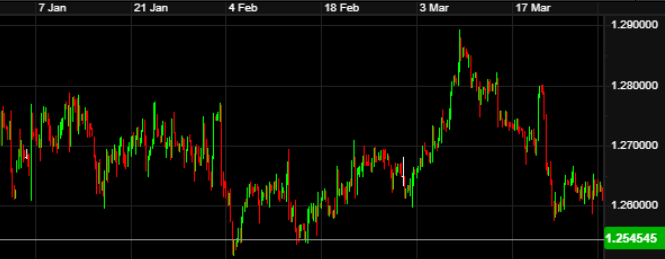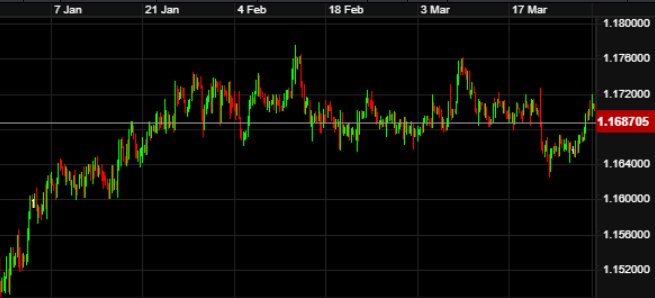ACM Update 02-04-24

The first quarter of the year is now officially behind us, topped off with an assortment of Easter eggs for good measure. Sterling saw 3% swings versus the Euro and US Dollar in Q1, but over 6% swings versus other G10 currencies.
Will we begin to see interest rates cuts from the Bank of England, Federal Reserve or European Central bank in Q2? Only time will tell.
With a shorter week last week, market releases were few and far between. UK events continued to surround market speculation on when the Bank of England will begin to cut interest rates. A month ago, the MPC were expected to be last of the big three to cut, now there is the possibility they may lead the charge.
A Bloomberg poll last week suggested that the probability of a cut in the next Bank of England meeting (9th May) is as low as 20% though. The ECB and Federal Reserve are both placed at less than 10% currently (11th April & 1st May respectively). Such headlines and potential changes are likely remain drivers for the major currencies as we move through the second quarter of the year.
The Bank of England’s arch-hawk Catherine Mann spoke last Monday, however she disagrees with the prospect of rate cuts any time soon. She suggests that that the Bank of England will cut after the Federal Reserve opt to.
Given current expectations are for the Federal Reserve to cut in September, this would change the economic landscape in the UK fairly dramatically. Very little else from the UK last week, and not much to come this week either, besides Services PMI numbers.
In the US, again much of the conversation was surrounding the future movements of interest rates. Jerome Powell was the highest profile of the speakers, reaffirming that the economy is still not suffering from the current interest rate levels.
Powell didn’t give away much about future policy, just stating that he expects inflation to “move to 2% on a sometimes bumpy path”. This could well be setting market expectations for any potential nudges back up in inflation over the coming months. The Fed Chairman has maintained for a while that the path to 2% inflation will not be linear.
His colleague Raphael Bostic commented that he is in no rush to lower interest rates. He wants to see “at least a couple of months of better inflation data”, calling recent figures “disappointing”. In turn he has scaled his inflation expectations back to just one cut this year. This does seem to all fall in line with current market forecasts that interest rates won’t be coming down in the US quite yet.
In terms of data, the US economy confirmed a strong end to 2023 with growth of 3.4% in Q4. This was even above the 3.2% forecast. US Unemployment Claims numbers remained stable last week at 210k, whilst the University of Michigan consumer sentiment figures recorded 79.4 for April. This is their best figure since July 2021. Plenty of positivity in the US.
You can see the volatility throughout Q1 of 2024 for Sterling vs the US Dollar in the chart below:

All quiet on the EU front so close to Easter. Spanish inflation bounced back up to 3.2% from 2.8% last month due to a rise in VAT on electricity (10% to 21%). German retail sales meanwhile fell by -1.9% month on month.
Elsewhere, Australian inflation remained at 3.4%, for the second month in a row, whilst retail sales there saw a monthly growth of 0.3%. The Canadian economy grew by 0.6% in January alone, boosted by improvements in the Education and Manufacturing sectors.
The Sterling-Euro chart for Q1 can be seen below also:

The week ahead:
Monday – UK Bank Holiday & Daylight Savings Time begins in UK & EUR
Tuesday – Australian Monetary Policy Minutes (01:30 UK time), SPA/ITA/FRA/GER/EU/UK Final Manufacturing PMIs (08:15-09:30), JOLTS Job Openings (15:00), Fed Williams (17:00) Fed Mester (17:05) & Fed Daly speeches (18:30)
Wednesday – EU CPI Flash Estimate exp 2.5% (10:00), ADP Non-Farm Employment Change (13:15), ISM Services PMI (15:00), Fed Powell speech (17:10)
Thursday – SPA/ITA/FRA/GER/EU/UK Final Services PMIs (08:15-09:30), US Unemployment Claims (13:30)
Friday – US Non-Farm Payrolls exp 205k & US Unemployment Rate exp 3.9% (13:30)
A slightly quieter start to the first week of the new quarter, largely dominated by events from the US. Speaking of which, a note to our international clients that daylight savings time began in the UK (& Europe) over the weekend, so our clocks went forward by an hour.
US jobs data will be the first big economic indicator of the new quarter. The usual start of the month releases of ADP Jobs and then Friday’s Non-Farm Payrolls data will give an idea on how the economy performed in March. A healthy number of jobs added (around 200k is the estimate), will ease the pressure on Powell & Co to cut rates soon, if the employment sector is remaining buoyant.
Powell himself has a speech on Wednesday afternoon. As always, his words could well be a major Dollar-driver.
In the UK, just a light dusting of Manufacturing and Services PMI data to keep markets entertained. The latter forming the biggest portion of the economy will be the one to watch on Thursday morning.
Meanwhile in the Eurozone, the latest round of inflation figures make an appearance on Wednesday morning. These are expected to show a further small drop in inflation back down to 2.5% from 2.6% the month before. Any more could build the hype for an ECB cut.
Despite movements of 3% for GBP versus the other big majors in Q1, this can be deemed as somewhat of a quiet quarter. Such levels of movement are actually very minor for three months, but are the sort of movements that can make a considerable difference to the property purchases of individuals or invoice payments of businesses.
To ensure you are protected against such movements in the next quarter and beyond, reach out to the team today for our assistance.
Have a great week.